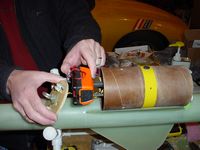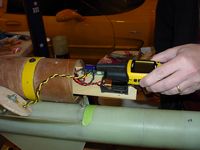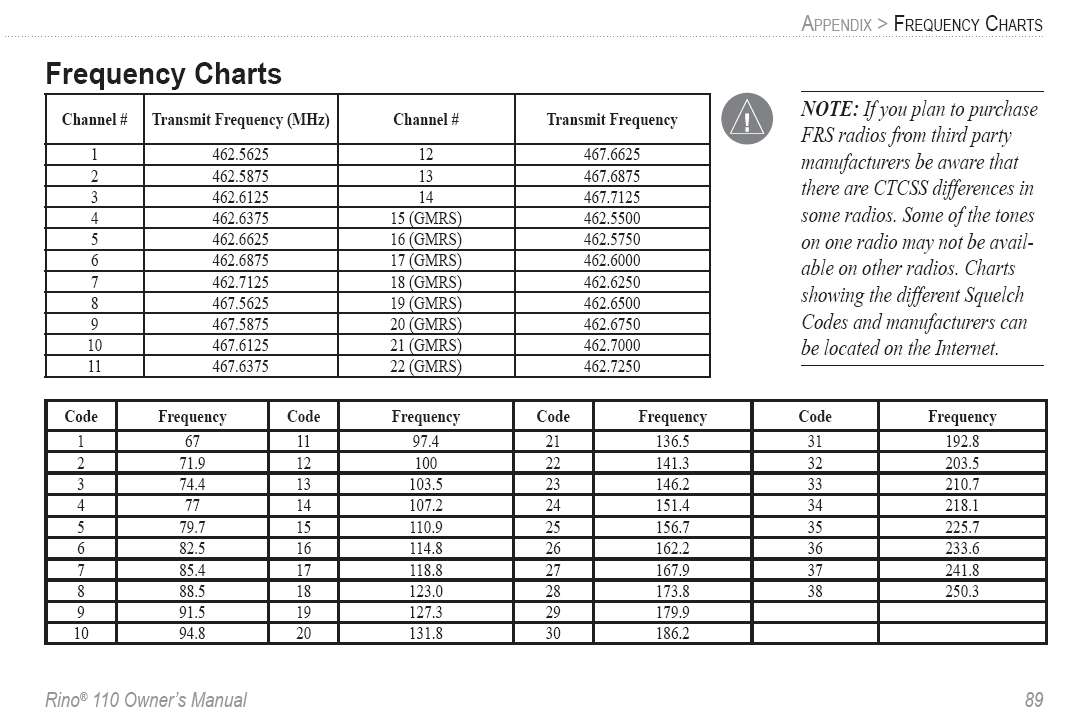Most of these units as they were designed for ground use have a lot larger output of 2 to 5 watts.. With the exception of some that are .5
with that much output its no wonder they have some issues with interferance.
We should have a separate GUIDELINES FOR RF along with ID allocation, but could be mentioned on a future ID RESERVE page. I'd be glad to help the web dudes on writing the html for those, if necessary.
Ken and I got together over lunch today to test his Rhino 110 (.5W) and my DC20 (5W) with his PerfectFlight MAWD. The Rhino was able to set a false launch (220 feet) with the PF, but the Rhino antenna had to be right on top of the altimeter. The DC20 however did not affect it. The wiring in his avbay was 6-8" long which (as he mentioned previously) and was tuned to the 1/4 wavelength of the FRS radio (about 400 Mhz). The 1/4 wavelength for a DC20 is about 18". We added a charge wire of 18" to his avbay but still could not get the PF to fire prematurely with the DC20.
DC20 on Left, Rhino 110 on right:

When the Rhino was tested with my MW RRC2-mini there was no false launch, however my DC20 again set it off, when the antenna was close by.
In all my tests, as a summary, if the TX is at least 6" away there are no problems, or if the avbay is shielded, but to be safe a 24" separation is recomended.
So far tests have been done with:
MW RRC2-X
MW RRC2-mini
MW PET2
PF Alt15K
PF MAWD
Adept
RCMS
I suspect that cell phones could affect systems with short wires. To be tested... 🙄
Most of these units as they were designed for ground use have a lot larger output of 2 to 5 watts.. With the exception of some that are .5
with that much output its no wonder they have some issues with interferance.
The power is not the primary problem, as .5W coupled into a 9V circuit could supposedly generate .055 amps into the Baro circuitry creating a voltage spike which reaches the threshhold of what is considered a launch. The PF is set at 200 feet, MW is set at 300. If one could change the launch threshhold higher there is less risk involved. The more finely divided A to D increments would have more of an issue as well (say a 45K altimeter vs a 15K altimeter) as the threshold is reached sooner with less voltage.
Predominately, Its the wiring going to the units, that act as antennas, that are the problem, transferring the energy to the altimeters, which must be detuned for any particular radio transmitter. The circuitry designs that uses ground planes are less susceptable to couple currents coming in from the wiring.
I have not seen an instance in my tests where a radio could affect a neighbors rocket, its only within the same rocket that the issue must be addressed (accept for ID management issues).
I wonder if using shielded or twisted pair wiring would resolve some or all of the RF coupling issue? One problem I note with most altimeters is that except for the power supply negative terminal, there's not much in the way of a ground to tie to. A common ground for things might also help.
Of course, in most cases you would put your transmitter up in the nose and the ebay down below the parachute bay. On some rockets the idea of 24" separation might be an issue, but considering that the DC20 is fairly sizable and would mostly fly in sizable rockets (excluding the circumstance of stripping one to bare essence to fly in a 38mm or 54mm bird), it shouldn't be an issue - at least in dual deploy birds.
Warren
So, would it be better to use the Astro 220 DC20 combo or a 70cm tx/rx system?
I am getting an Astro setup as well, but am not sure what to use in my VA. I have an old dog that I need it for when we go camping, the rocket would make the $450 price tag a bit easier to stomach.....
PS, I still have a 2x4 dry erase board and easel that I will donate to the club if someone wants to get it from me. I will be at MHM, but whoever is doing setup might like to have it in advance.
Thanks - it might be a good idea to bring it along, but I think the club already has like a 2' x 3' whiteboard for the big launches.
W
I wonder if using shielded or twisted pair wiring would resolve some or all of the RF coupling issue? One problem I note with most altimeters is that except for the power supply negative terminal, there's not much in the way of a ground to tie to. A common ground for things might also help.
Warren,
I can tell you that twisted pair didn't help with the Rino (or it helped, but was not sufficient.) However, I could only get the MAWD to trip if the transmit antenna of the Rino was lying right next to the wiring (all in the 6" length range). I would probably be OK with it in the ebay, on the opposite side of the sled, but moving it up to the nose would make things warm & fuzzy. It's all a matter of your gambling threshold!
BTW, I suggested decoupling caps to Mike and he has tried it already with no benefit. He's had EMI experience, so I expect he's done his homework on this.
Anyone got a suggestion on how to do a removable bulkhead on a LOC plastic 4" cone? I need roughly a 3" dia. cavity for the Rino.
Ken
Anyone got a suggestion on how to do a removable bulkhead on a LOC plastic 4" cone? I need roughly a 3" dia. cavity for the Rino.
Ken
Ken, I suggest cutting of the tail end up to the coupler diameter, then epoxying in a bulkhead to which you would mount a plate, like I did in my 5" Slipstick III. If you bring the Nose cone over, I can cut you a 1/2" thick plywood ring using a circle cutter on a drill press (or you can do it while I do other things). The circle cutter is fine with G10 as well if you have some. See this page of my website for a step by step process on cutting out the ring and attaching it to the nose cone.
http://telerover.com/rockets/L3-6.shtml
Here's a couple thumbs:





The other option is to cutout a 3" diameter hole concentric with the NC and insert a 3" tube. PML did that on a 2.1" payload prototype that they sent me to evaluate. I can help you cut that out (with a rotary tool).
Mike,
Can you have multiple receivers tracking the same rocket transmitter at the same time? For example, could I track from the launch site and have someone else positioned a few miles downwind tracking the same rocket?
Or, is it strictly a one to one pairing of transmitter to receiver?
I bought into a system, but have not been able to test a 2:1 configuration for added margin.
I need some input from the boss men.
I am going to let Scott use one of my Beelines in his little bird and need to know what frequency (70CM) you want me to tune it to.
FYI, I'm using a DC20 in my VA.
Greg
Greg wanted me to let everyone know, the 2 B-lines we will be using will be on 449.850 plus what ever the Dog collers are runnimg on.
Scotte
449.850 is definitely a non-interfering frequency for the Adept beacon transmitters - our main concern. The Adept's are typically 433.750 at the center though they drift as low as 433.5 and as high as 433.9.
Warren
Mike,
Can you have multiple receivers tracking the same rocket transmitter at the same time? For example, could I track from the launch site and have someone else positioned a few miles downwind tracking the same rocket?
Or, is it strictly a one to one pairing of transmitter to receiver?
I bought into a system, but have not been able to test a 2:1 configuration for added margin.
As far as I know,(last time I talked to Garmin) is that multiple handhelds can be used with the same rockets(dogs). The handheld has to'identify' the DC20 first, however. We can try it at MHM. I've got three DC20's now captured in my handheld (Greg Sctott's "Hair-Of-TheDog").
I'll have DC20 with me to test with the handhelds.
Warren



